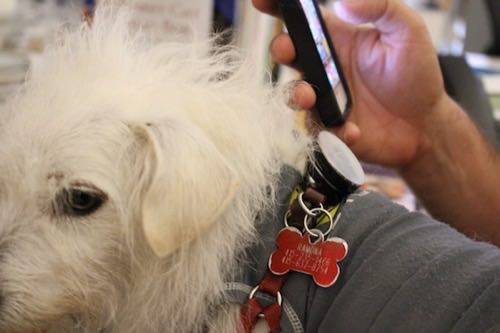
ReadWriteBody is an ongoing series where ReadWrite covers networked fitness and the quantified self.
It’s funny to think how much of my fitness routine revolves around my dog, Ramona the Love Terrier. Until this 11-lb. bundle of love and energy joined our family three and a half years ago, I never ran outside—I was strictly an indoor treadmill-and-elliptical guy. I quickly realized that there was no question of walking this dog: Ramona, a Jack Russell mix, needed to run, jump, climb hillsides and gambol.
And so I joined in. A morning run around Telegraph Hill is now part of our daily ritual. On nice days, I walk to the office rather than take the streetcar, so Ramona gets outdoor time. And on weekends, we explore more of San Francisco—destinations like Aquatic Park, Fort Mason or even Crissy Field. It’s exercise for me and for her.
But how much exercise is Ramona getting? Is it enough? And is she resting enough to recuperate? A new device from a company called Whistle Labs promises to answer that.
The Quantified Woof

Photography shot with the Canon EOS Rebel SL1 digital SLR camera. Small in size, enormous in performance.
Whistle cofounder Steven Eidelman stopped by ReadWrite headquarters the other day to help fit Ramona with a Whistle tracker. It was remarkably easy: I actually had less hassle setting up the Whistle than with some of the devices I use to track myself. Rubber straps secure it to a dog’s collar or harness. To configure it, I paired it with a Bluetooth connection to my iPhone, then configured it to connect directly to Wi-Fi networks at home and at work.
I also set up my brother and sister-in-law with the Whistle app, so they can monitor Ramona’s activity. Whistle even detects the proximity of designated humans, so it knows if Ramona is taking a walk with me or with my husband.

In a particularly clever touch, the Whistle tracker twists off a holder and slips into a charger, so you don’t even have to remove it from your dog’s collar. I’d like to see similar features in more human trackers, where far less thought seems to have been put into the charging experience.
The Tracks Of A Terrier
Before the Whistle, I was already quantifying Ramona in some sense: Most of my runs are with her, and a large part of the reason for my frenetic Foursquare activity is to mark all the spots where Ramona goes.
But the Whistle’s reports gave me peace of mind that I was, indeed, being a good human to my dog. A comparison to similar dogs informed me that Ramona was simultaneously getting more exercise—75 minutes a day of activity—while still managing to get more rest than the average pup. Call it the Lake Wobegon effect, but this data pleased me.

Was it useful? I did notice that on days when Ramona stayed home, she got less activity. That tells me that taking her into work, as I do most days, is good for her as well as for me.
I’m keen on using the Whistle to alleviate my separation anxiety when we’re apart for the Thanksgiving holiday. The flight to the East Coast is too long for Ramona, so she stays behind in California with family. I’ll be able to keep an eye on her remotely, and reassure myself that she’s being well-cared for.

The Internet Of Dogs
Is that worth the cost? The Whistle is available for $99.95 for preorders, with shipments arriving later this year; it will go on sale at retail establishments for $129.95 next year. (A similar tracker, the FitBark, starts shipping in January.) While I dote on Ramona, I don’t spend a lot on toys or treats for her; she’s pretty happy chasing a tennis ball around the house.
For everyday tracking, I don’t think I need to quantify my dog: I can tell with a look that she’s well-exercised. (And she lets me know if she’s bored.) But the ability to keep track of her remotely is the real selling point for these devices, I think.

The dependence on Wi-Fi for data uploads is the main limitation of the device. Eidelman tells me an update which lets it transfer data via Bluetooth to phones, and then up to Whistle’s servers over their wireless connections, is coming. Longer battery life would help, too, so you don’t have to hand a charger to a host who’s taking care of your dog and explain how to maintain the Whistle.

A smaller size would help, too: Ramona, at 11 lbs., is on the small side for what Whistle recommends. (On a larger dog, it’s less obtrusive.)
But those improvements seem inevitable, given the rapid pace of innovation in hardware these days. The Internet of Things is coming to our homes; why shouldn’t our pets be a part of it?
Disclosure: Canon, the official camera of Point-of-View Publishing, provided ReadWrite with an EOS Rebel SL1 digital SLR camera and paid to be mentioned in a caption and sidebar in this post.

















